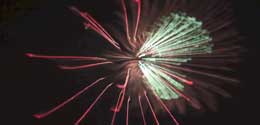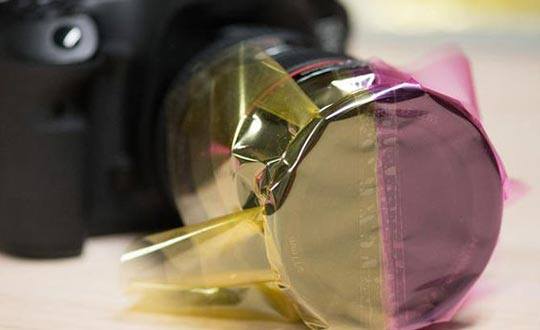Now that we're comfortably settled in the digital era, after talking with lots of students and fellow photographers, I've compiled a list of things that photographers might want to receive (or acquire for themselves) this holiday season.
I'm not necessarily talking about the cutting-edge gear that top-notch professionals use, just stuff that might help anyone take better pictures and have more fun with photography. To help people on a budget (Who isn't these days?), I've listed items by price range.
Free: Get a Community
Join www.fotki.com. We discovered Fotki this summer when they offered to be our partner in the NYIP Focus: Your Hometown Photo Contest. Unlike flickr, photobucket, and some of the other big sites, Fotki has a lot of interesting things to offer. Like very inexpensive high quality prints. Like no limit on the size of the file you can upload. And how about free photo hosting for your blog or auction site?
Fotki's staff is mostly based in Estonia but they have an office in New York City as well. We're told Tallinn (Estonia's capital and Fotki's home town) is a great European city and has been since about 1100. We plan to visit as soon as possible. The Fotki staff we've worked with and met have been a pleasure and they're all serious about photography. Worth a look and the price is right.
Free: Google's Picasa.
Actually, this is Google's present to you. All you have to do is download http://picasa.google.com/ the free program. Sorry Apple people, this free download is just for PC users although you can use Picasa's Web album application. (While we're on the subject of Apple, why is it that iPhoto is one of the least satisfying Apple offerings in the opinion of many people?)
For folks who take lots of photos but who haven't invested the time or money in photo organization software, Picasa is a great way to manage pictures. Even the most technically challenged computer users find it a handy way to store and sort photos, burn them to CDs, downsize them for e-mail, and even do a little image editing. If you bought Google when it went public at $100, then you already have a present. If not, help yourself to this one. BTW, I do not own any Google stock.
Visit www.nyipodcast.com to hear my friend, NYIP teacher and hard-working pro Walter Karling discuss his adventures with Picasa.
$3.00: A Gray Card for those tricky exposures.
Need to take a picture of a very light subject or a very dark one? How about a small dark subject against a very light background? Or vice-versa? How do you get a decent exposure in tricky situations like these? Easy —put something in front of your camera that will work with the reflected light meter in your camera. That would be a gray card, which is what your meter expects to see —a gray middle tone. That's why without extra steps very dark scenes turn out gray and very light scenes also turn out gray. We think a gray card is so handy we send one to every student in our Complete Course in Professional Photography.
In this era of auto exposure, there are lots of exposures that are "good enough." But those tricky scenes that don't contain the middle tones that your meter presumes to be in front of it still cause problems. Gray cards are hard to come by these days. Kodak used to sell a very good gray card for $20, but it's been backordered for over a year. There are a few on the market for about $4, and one for $34.95. Here's our offer: If you live in the U.S. or Canada: send $3.00 US via check, money order, or cash, and we'll send you two gray cards along with instructions on how to use your gray card to get accurate exposures every time. If you live somewhere other than the U.S. or Canada, e-mail us for instructions. The NYIP gray card isn't as perfect an 18% neutral gray as Kodak's, but it's pretty darn good and far, far better than no gray card at all.
Here's the address...
Gray Card Special Offer
New York Institute of Photography
211 East 43rd Street
New York, New York 10017
Under $25: A Year's subscription to a great photography magazine.
Thanks to the work of talented editors there are a number of printed magazines that are better than ever.
For the person just getting started, Popular Photography is a natural choice. Cost: $14 for a year (or less if you subscribe online with a credit card).
For the more advanced photographer there's no better read than Shutterbug https://www.shutterbug.com for $18.
The busy folks at Werner publishing have three interesting magazines —Outdoor Photographer, PC Photo, and Digital Photo Pro. One thing about the folks at Werner is that they're very good at naming their magazines in a way that let's you know exactly what they're all about. They also have odd numbers of issues, so in one year you can get 11 issues of Outdoor for $15, 9 issues of PC Photo for $12, or 6 issues of Digital Photo Pro for $20.
$24.99: JPG Magazine —the first Web 2.0 Photo Magazine
Unlike conventional photography magazines, JPG Magazine and the integral Web component www.jpgmag.com specialize in user content. Upload your pictures to the site, and other jpg members/fans comment and vote on what should appear in the next printed issue of the magazine. Final selection, layout and design is done by a JPG editor or guest editor. Each issue features a few themes.
The people behind JPG came to visit NYIP World Headquarters this summer and we think they're on to something really subversive here —putting the readers/community members in charge. In addition to pictures, community members can suggest story ideas or even submit stories for consideration. While everything is viewable online, the printed magazine is really good looking and features lots of very interesting photographs and very limited advertising. JPG Magazine is just coming onto people's radar now, and the company behind JPG, 8020 Publishing was recently featured in a favorable article in the New York Times.
Six issues are $24.99 at www.jpgmag.com. By the way, if one of your pictures is used in a printed edition of JPG Magazine, you get $100 and a year's free subscription!
$25 - $35: Holga and Diana: Get back to photography's roots with a plastic camera.
Are you suffering from megapixel overload? Find yourself underwhelmed by the latest burst rate breakthrough from Can-kon-ony-olym-tax? Sick of everything being done for you automatically? Want a camera without electronics?
Maybe it's time for you to consider something that fine art photographers do from time to time —get back to the basics with a 120 film camera. For years the Diana, originally selling for under $1.00, was a collector's item fetching $70- $100 on eBay, but now the wild and crazy folks behind Lomo have brought the camera back into production. If the new version is as poorly made as the old ones, you need to learn to love light leaks or learn to tape the camera up with light-tight tape. The shutter speed is 1/60 of a second and you get a choice of three apertures, wide open, a little smaller, or a little more smaller. I've shot loads of film with my vintage Dianas and worked a bit with the Holga. I suggest you start with ISO 400 film, either Tri-X or color negative. As exposures are a bit unpredictable, slide film is risky.
You can pay a bit more and support the fine folks at Lomo, by visiting www.lomography.com, which is worth a visit anyway. For the best price, shop Amazon.com. Or, you can overpay at U**** O********. Your choice.
$43. to $602. A Good Tripod.
One of the things the folks at Popular Photography really like to do is test stuff and give us lots of shopping information. For example, they have a "High Five" series in which they list their top five picks in a category. In their December issue they list five different tripods that range from for lean-and-mean to for a model that's tricked out with a high quality head. Prices listed are "street price" which you can usually beat by a few bucks if you work hard at it.
Personally, testing tripods and other gear is something I find really boring so I'm very glad the magazines offer this service. Outdoor once ran a ball-head roundup that described something like 18 different models. I sent the author a condolence note. I would be hard pressed to find something to say about two or three ball-heads, much less conducting a comprehensive survey.
My own tripod collection has a few littles, two sturdies (one lives in the trunk of my car) and a monster in the office/studio at NYIP World Headquarters. Now I know you may think you can hold a camera rock steady and in today's world of vibration reduction lenses and camera bodies, who needs a tripod anyway? The answer is you do if you don't own one, simply because there are lots of great low light photo opportunities where even the Hulk isn't vibration free. Also, working in a studio or portrait setting, it's great to maintain precise camera position while you rearrange the lights, then adjust the thing you're shooting for an auction site, or discipline an unruly model.
$60 to whatever: A Digital Picture Frame.
The industry watchers and trend spotters told us that last Christmas this was the hottest selling item in the photo category and that most suppliers sold out ahead of Christmas.
Well, don't worry, they're ready this year, and it does make perfect sense. All those digital photos out there and not so many prints being made, and no one having that much time any more, how do you show your pictures? There are wireless models, models that you link to your computer, models that hold a memory card and show everything on the card, and probably lots of other features I don't understand, such as the opportunity to record voice to go with the pictures.
There are models with little screens and models with big screens. As you might imagine, the bigger the screen generally means the higher the price. When I googled "digital picture frame" our friends at Ritzcamera.com had the top spot, which I bet isn't cheap. I suggest you shop around, but ritzcamera.com is a good place to start. They offer free shipping on orders over $100, no sales tax, and a lot of models under their house brand Quantaray. Generally, Quantaray items are made for Ritz by top-flight manufacturers and given that label so they don't compete with other items made by the same manufacturer. By the way, any NYIP students reading this: don't forget you get an extra discount on everything at ritzcamera.com. If you don't know the details, send an e-mail to the school with your name and student ID number and we'll give you the special code.
Under $100: A 5-in-1 circular reflector.
It never fails - every time I demonstrate to a live audience of beginners the effect of a reflector fill, the crowd "oohs" and "aahs." The inexpensive solution is a sheet of white poster board from your local office supply store, but for around you can find a nice 36-inch circular reflector with white, gold, silver reflective surfaces, perhaps an inner nylon translucent panel you can shoot through, and a black surface you can use to flag stray light. With a twist and a flourish, the circular reflector collapses to a handy size to fit in a gear bag.
Under $400:
NYIP's Short Course: Fundamentals of Digital Photography OK, OK, I know this is self-serving, but with sixteen beautiful full-color lessons, personal tech support, individual evaluations of your pictures, over eight hours of compressive audio presentations and NYIP's 2-1/2 hour Weekend Photo Workshop DVD video, this is a great way for the person who is just getting started with photography to learn how to take control of a high-performance digital SLR or point-and-shoot. In addition to NYIP's custom multi-media learning materials, NYIP's Short Course students get to submit two Photo Projects for evaluation by NYIP's teaching staff of professional photographers and a certificate of completion. If that weren't enough, you're assigned a student advisor who's available to answer all your questions.
Under $500: An off-camera flash and light stand.
For the photographer who is starting to get serious, there's nothing like a flash that isn't attached to the camera. Sure, the little pop-up that comes with your camera or even an add-on unit that fits onto the camera's hot shoe is handy for snapshots. But, direct light from atop the camera is harsh and shows every detail. That's fine for the paparazzi and crime scene photography, but when you're ready to start taking interesting portraits or product photos, you need to move the light away from the camera.
One approach is to buy a flash from your camera's manufacturer that will work remotely. These offerings vary, so you'll have to do some research.
Another approach is to get a stand-alone model such as a monolight that has the flash and the charger in one compact unit that sits atop a light stand. You'll need to plug it into an AC power supply, and you may want to add a wireless trigger to make life easier. There are lots of big names in the field that make great equipment including Bowens, Broncolor, Dyna-Lite, Elinchrom, Norman, Photogenic, and Speedotron, but for under $500, I suggest the direct order services of Alien Bees and the Beginner Bee Kit. NYIP students (and students in other educational programs) qualify for an extra discount as well. Details at www.alienbees.com.
Under $1000: A new digital SLR.
Personally I'm itching for the new Nikon D300, which is a bit over ,000, but there are lots of great digital single lens reflex cameras out there in the under category and I've fiddled with all of them at the trade shows. You can take great pictures with any of them.
My loyalty to Nikon stems from owning a lot of Nikon-mount glass, but you can't go wrong with (in alphabetical order) a Canon Rebel xTi (although the photo world expects a new digital Rebel model soon to compete with Nikon's D40x), Nikon D40x, Olympus EVOLT E-510, Pentax K10, Sony Alpha 100. There are other manufacturers of digital SLRs, but I'd go with one of these five. They've all been in the camera business for a long time. Even Sony? Well, since their Alpha series is based on the old Minolta camera assets, yes.
That's my list!
Did I miss something on your's? If so, e-mail me at NYIP as I'll be collecting suggestions for next year's edition. Happy Holidays, and get out there and take some photographs!
Get the photography buff in your life the perfect gift for the holiday season! (besides enrolling them in one of our online photography courses of course!)







